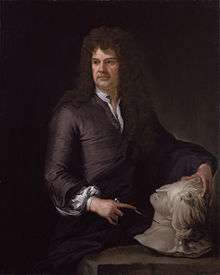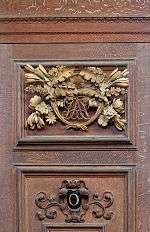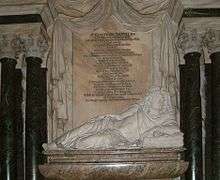Grinling Gibbons

Grinling Gibbons (4 April 1648 – 3 August 1721) was a Dutch-British sculptor and wood carver known for his work in England, including Windsor Castle and Hampton Court Palace, St. Paul's Cathedral and other London churches, Petworth House and other country houses, Trinity College Oxford and Trinity College Cambridge. Gibbons was born and educated in Holland of English parents,[1] his father being a merchant. He was a member of the Drapers' Company of London. He is widely regarded as the finest wood carver working in England, and the only one whose name is widely known among the general public. Most of his work is in lime (tilia) wood, especially decorative Baroque garlands made up of still-life elements at about life size, made to frame mirrors and decorate the walls of churches and palaces, but he also produced furniture and small relief plaques with figurative scenes. He also worked in stone, mostly for churches. By the time he was established he led a large workshop, and the extent to which his personal hand appears in later work varies.
Life
Very little is known about his early life. The name Grinling is formed from sections of two family names. He was born in Rotterdam, Netherlands, and it is sometimes thought that his father may have been the Englishman Samuel Gibbons, who worked under Inigo Jones, but even two of his closest acquaintances, the portrait painter Thomas Murray and the diarist John Evelyn, cannot agree on how he came to be introduced to King Charles II. He moved to Deptford, England around 1667, and by 1693 had accepted commissions from the royal family and had been appointed as a master carver.[2] By 1680 he was already known as the "King's Carver", and carried out exquisite work for St Paul's Cathedral, Windsor Castle, and the Earl of Essex's house at Cassiobury. His carving was so fine that it was said a pot of carved flowers above his house in London would tremble from the motion of passing coaches.
The diarist Evelyn first discovered Gibbons' talent by chance in 1671. Evelyn, from whom Gibbons rented a cottage near Evelyn's home in Sayes Court, Deptford (today part of south-east London), wrote the following: "I saw the young man at his carving, by the light of a candle. I saw him to be engaged on a carved representation of Tintoretto's "Crucifixion", which he had in a frame of his own making." Later that same evening, Evelyn described what he had seen to Sir Christopher Wren. Wren and Evelyn then introduced him to King Charles II who gave him his first commission - still resting in the dining room of Windsor Castle.
Horace Walpole later wrote about Gibbons: "There is no instance of a man before Gibbons who gave wood the loose and airy lightness of flowers, and chained together the various productions of the elements with the free disorder natural to each species."
Gibbons is buried at St Paul's, Covent Garden, London.
Work


Gibbons was employed by Wren to work on St Paul's Cathedral and later was appointed as master carver to George I. He was also commissioned by King William III to create carvings, some of which adorn Kensington Palace today. An example of his work can be seen in the Presence Chamber above the fireplace, which was originally intended to frame a portrait of Queen Mary II after her death in 1694. Also in the Orangery at Kensington, you can see some his pieces. Many fine examples of his work can still be seen in the churches around London - particularly the choir stalls and organ case of St Paul's Cathedral. Some of the finest Gibbons carvings accessible to the general public are those on display at the National Trust's Petworth House in West Sussex, UK. At Petworth the Carved Room is host to a fine and extensive display of intricate wooden carvings by Gibbons.
His association with Deptford is commemorated locally: Grinling Gibbons Primary School is in Clyde Street, near the site of Sayes Court in Deptford. Most of present day New Cross and Brockley wards were in 1978-1998 part of the Grinling Gibbons ward.[3]
His work can be seen in the London churches of St Michael Paternoster Royal and St James, Piccadilly, where he carved the wood reredos and marble font. The Anglican dislike of painted altarpieces typically left a large space on the east wall that needed filling, which often gave Grinling's garlands a very prominent position, as here.
The famous sculptor of Brussels Peter van Dievoet had collaborated with Grinling Gibbons, but went back to Brussels after the revolution of 1688.
.jpg)
St Michael and All Angels Church, Badminton, has a monument by Gibbons to Henry Somerset, 1st Duke of Beaufort (1629–1700). He was buried alongside his ancestors in the Beaufort Chapel in St George's Chapel, Windsor,[4][5] but the monument was moved to Badminton in 1878.[6] The monument by Gibbons is now on the north side of the chancel at St Michael and All Angels Church, Badminton, and consists of an effigy of the Duke in Garter robes, reclining on a sarcophagus and a plinth with relief of St George and the Dragon. There are twin Corinthian columns with embossed shafts, acanthus frieze, cornice with flaming urns, and the Duke's arms and supporters. At the top, 25 ft from the ground, is a tasseled cushion supporting a coronet; on the plinth are full-length female figures of Justice and Truth. Above the Duke's effigy, parted curtains show the heavenly host with palms and crowns. The Latin inscription displays the names of his family and the many offices he held.[7]
St. Peter and St. Paul church in Exton, Rutland has a fine marble tomb by Gibbons, dating from 1685, showing Viscount Campden with his fourth wife, Elizabeth Bertie, and carvings of his 19 children.[8]
Gibbons also made the monument for Admiral Sir Cloudesley Shovell, a British naval hero killed in a disastrous shipwreck in 1707. Shovell's large marble monument can be seen in the south choir aisle of Westminster Abbey.[9]
Gibbons' work very often includes carvings of peapods. A myth states that he would include a closed pod in his work, only carving it open once he had been paid. If the pea pod was left shut it supposedly showed that he had not been paid for the work.
In Popular Culture In the first episode of the British television comedy Doctor in the House, it is mentioned by one of the professors to the students that the interior decorations for St. Swithins were done by Grinling Gibbons.
Bibliography
- The Carved Cartoon: A Picture of the Past, Austin Clare 1873
- The Work of Grinling Gibbons, Geoffrey Beard, John Murray 1989 ISBN 0-7195-4728-8
- Grinling Gibbons and the Art of Carving, David Esterly, V&A Publications 2000 ISBN 1-85177-256-1
Notes
- ↑ V&A exhibition information, accessed 18 January 2013
- ↑ "Grinling Gibbon", Encyclopaedia Britannica, accessed 30 September 2009.
- ↑ London Borough of Lewisham
- ↑ St George's Chapel, Windsor: The Beaufort Chantry, 19 July 2013
- ↑ For the inscription see Ashmole's Berkshire, iii. 163 (Seccombe 1898, p. 245)
- ↑ Seccombe 1898, p. 245.
- ↑ St. Michael and All Angels, Great Badminton (webpage), 19 July 2013
- ↑ "TOMB OF VISCOUNT CAMPDEN AT EXTON CHURCH". World Monuments Fund.
- ↑ "Sir Clowdisley Shovell's tomb and memorial in Westminster Abbey". Retrieved 29 January 2010.
External links
-
 Media related to Grinling Gibbons at Wikimedia Commons
Media related to Grinling Gibbons at Wikimedia Commons -
 Chisholm, Hugh, ed. (1911). "Gibbons, Grinling". Encyclopædia Britannica (11th ed.). Cambridge University Press.
Chisholm, Hugh, ed. (1911). "Gibbons, Grinling". Encyclopædia Britannica (11th ed.). Cambridge University Press.